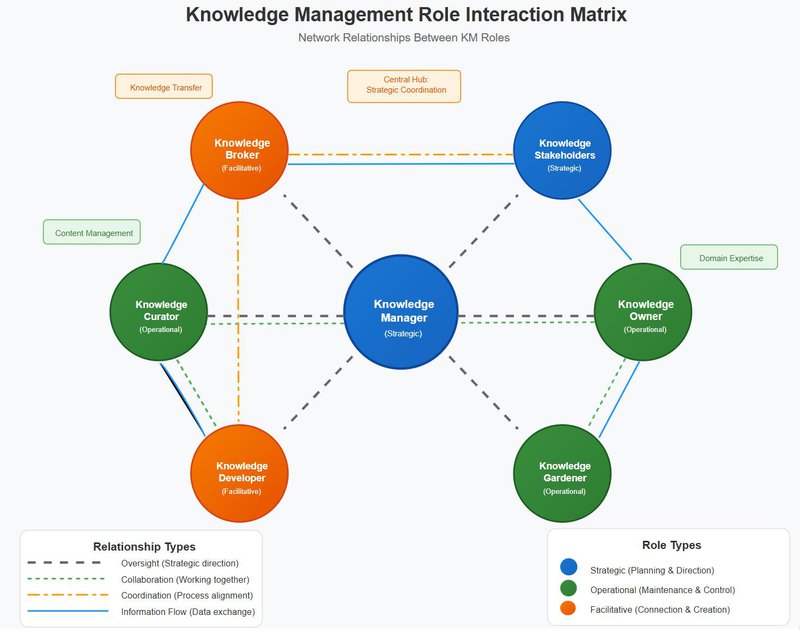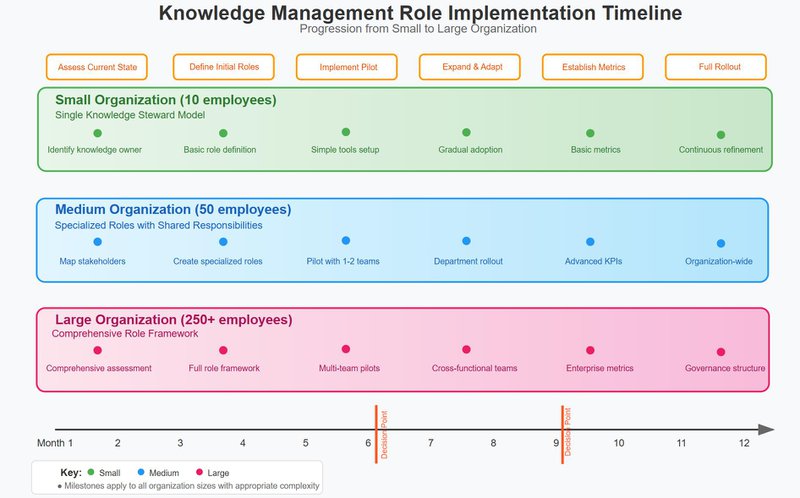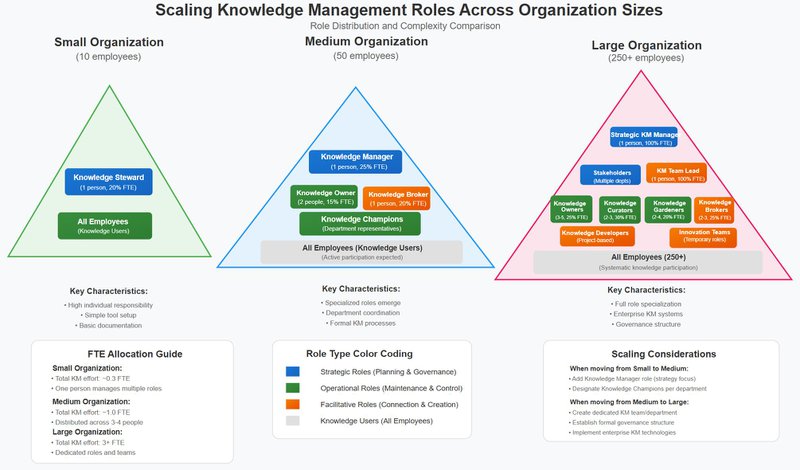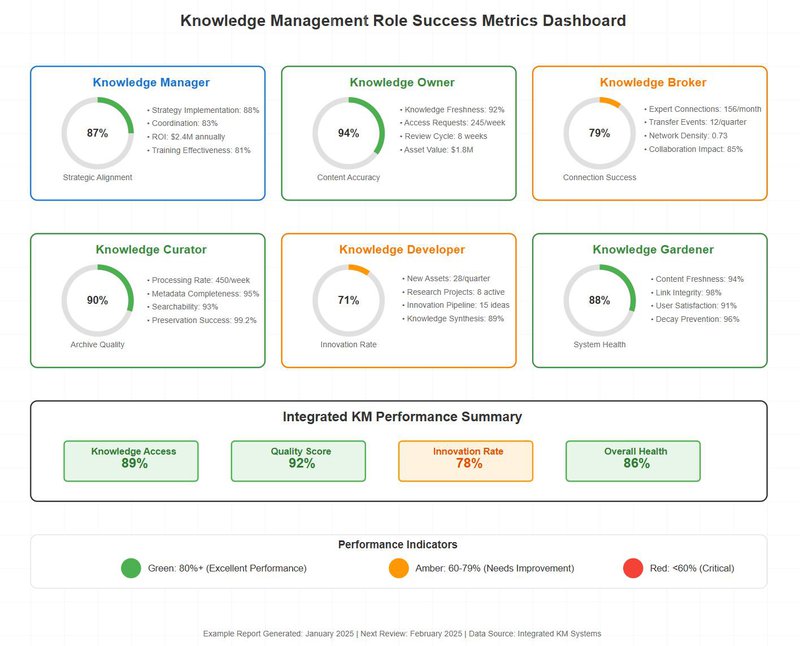
Introduction
In today's rapidly evolving business landscape, knowledge has become the ultimate competitive advantage. Yet a recent study by McKinsey reveals that 90% of organizational knowledge remains trapped in employee heads, inaccessible when most needed. This knowledge isolation costs companies an estimated $47 million annually in duplicated efforts, missed opportunities, and reinvented solutions.
The problem isn't a lack of information systems or collaboration tools. Instead, it's the absence of clearly defined roles and responsibilities that ensure knowledge flows freely, gets properly maintained, and creates lasting organizational value. Just as every successful garden needs a skilled gardener, every knowledge management initiative requires dedicated roles to cultivate, organize, and protect your intellectual assets.
In this article, we'll explore the essential roles in knowledge management that transform information chaos into structured wisdom. You'll discover how to identify the right people for each role, understand how these positions adapt to organizational size, and learn practical strategies for implementing a role-based knowledge management approach. By the end, you'll have a clear roadmap for building a knowledge ecosystem where every piece of information has its place and every insight finds its purpose.
We'll cover the seven core knowledge management roles—from the strategic Knowledge Manager to the metaphorical Knowledge Gardener—and show how these responsibilities scale from small teams to large enterprises. Whether you're leading a 10-person startup or managing knowledge in a 250-employee organization, these principles will help you create a thriving knowledge environment.
Understanding Knowledge Management Roles: The Conceptual Foundation
Knowledge management roles represent specialized positions dedicated to the systematic handling of organizational knowledge. Unlike traditional job titles that focus on operational tasks, these roles concentrate on capturing, organizing, sharing, and applying intellectual assets across an organization.
The evolution of knowledge management roles traces back to the 1990s when Peter Drucker first coined the term "knowledge worker." As organizations recognized knowledge as a critical asset, specific roles emerged to manage this resource. Initially, these responsibilities were often informal add-ons to existing positions. Today, they've evolved into sophisticated frameworks that align with organizational strategy and culture.
Within the knowledge management context, these roles serve multiple interconnected functions. They bridge the gap between isolated information and actionable insights, transforming tacit knowledge (what people know but haven't documented) into explicit knowledge (documented and shareable information). Each role addresses specific aspects of the knowledge lifecycle—creation, capture, organization, sharing, application, and preservation.
The current relevance of these roles has intensified with digital transformation and remote work trends. As organizations become more distributed, the need for systematic knowledge management becomes critical. These roles ensure that valuable expertise doesn't walk out the door with departing employees and that new team members can quickly access the knowledge they need to be productive.
The Seven Essential Knowledge Management Roles
1. Knowledge Owner
The Knowledge Owner serves as the guardian of specific knowledge domains within an organization. They possess deep expertise in particular areas and take responsibility for ensuring the accuracy, currency, and relevance of information within their domain.
Key responsibilities include:
- Maintaining and updating domain-specific knowledge repositories
- Validating information accuracy and removing outdated content
- Controlling access permissions and usage rights
- Establishing quality standards for their knowledge area
Effective Knowledge Owners combine subject matter expertise with strong organizational skills. They understand not just what information to maintain, but why it matters and how others will use it. They serve as the first line of defense against knowledge decay, regularly reviewing and refreshing their domains.
2. Knowledge Stakeholders
Knowledge Stakeholders represent the various groups that benefit from or influence knowledge management initiatives. They include end-users, department heads, senior leadership, and external partners who rely on organizational knowledge.
Their roles encompass:
- Defining knowledge requirements and use cases
- Providing feedback on knowledge accessibility and relevance
- Supporting knowledge sharing initiatives within their areas
- Advocating for knowledge management investments
Understanding stakeholder needs is crucial for successful knowledge management. These individuals provide the demand perspective that shapes how knowledge gets organized and presented. They help identify gaps between what knowledge exists and what's actually needed for decision-making and problem-solving.
3. Knowledge Manager
The Knowledge Manager takes the strategic overview of organizational knowledge initiatives. This role combines tactical execution with long-term planning, ensuring knowledge management aligns with business objectives.
Primary functions include:
- Developing knowledge management strategies and policies
- Selecting and implementing knowledge management tools
- Coordinating between different knowledge roles and departments
- Measuring and reporting on knowledge management effectiveness
Knowledge Managers need both technical understanding and business acumen. They must navigate organizational politics, secure resources, and demonstrate the value of knowledge management investments. They serve as change agents, helping organizations shift from information hoarding to knowledge sharing cultures.
4. Knowledge Broker
Knowledge Brokers facilitate connections between knowledge creators and knowledge users. They act as intermediaries who understand both what knowledge exists and who needs it, creating valuable bridges across organizational silos.
Essential activities include:
- Identifying and mapping expertise within the organization
- Connecting people with relevant knowledge and experts
- Facilitating knowledge transfer between departments
- Promoting cross-functional collaboration and learning
Successful Knowledge Brokers possess strong interpersonal skills and extensive organizational networks. They understand the informal communication patterns that often govern knowledge sharing and work to formalize these connections for broader benefit.
5. Knowledge Curator/Archivist
Knowledge Curators focus on the long-term preservation and organization of organizational knowledge. They ensure that valuable information remains accessible and usable over time, fighting against the natural tendency toward information decay.
Core responsibilities include:
- Designing and maintaining knowledge architecture
- Implementing retention and disposal policies
- Creating and enforcing metadata standards
- Managing version control and knowledge evolution
These individuals combine archival science principles with modern information management practices. They think in terms of decades rather than quarters, ensuring that today's innovations become tomorrow's foundational knowledge.
6. Knowledge Developer
Knowledge Developers actively create new knowledge through research, innovation, and synthesis of existing information. They transform raw data into actionable insights and drive knowledge creation initiatives.
Key functions include:
- Conducting research and analysis projects
- Facilitating knowledge creation workshops and sessions
- Synthesizing information from multiple sources
- Developing new methodologies and best practices
Knowledge Developers thrive at the intersection of curiosity and practicality. They possess both analytical skills to process complex information and creativity to generate novel solutions and insights.
7. Knowledge Gardener
As explored in our previous article, the Knowledge Gardener represents a holistic approach to knowledge maintenance. This metaphorical role embodies the continuous care required to keep knowledge systems healthy and productive.
The Knowledge Gardener's approach includes:
- Regular cultivation of knowledge through updates and enhancements
- Pruning outdated or irrelevant information
- Protecting knowledge from corruption and degradation
- Nurturing connections between different knowledge domains
This role emphasizes the organic nature of knowledge management, recognizing that information systems require constant tending to remain valuable. Like a garden, knowledge thrives with regular attention and withers with neglect.

Implementing Roles Across Organization Sizes
The implementation of knowledge management roles must scale appropriately with organizational size and complexity. Let's examine three distinct approaches:
Small Organizations (10 employees)
In small organizations, budget and headcount constraints require a minimalist approach. Here, flexibility and multifaceted roles are essential.
Recommended structure:
- Primary Knowledge Steward (1 person): Combines Knowledge Owner, Knowledge Gardener, and Knowledge Broker functions. This individual handles basic documentation standards, facilitates knowledge sharing, and maintains simple repositories.
- Universal Knowledge Users: All employees participate actively in knowledge creation and maintenance. Everyone owns responsibility for their expertise areas and contributes to collective knowledge.
Practical implementation:
- Use simple, accessible tools like shared cloud storage or basic wikis
- Hold weekly 15-minute knowledge sharing sessions
- Implement peer review for important documents
- Create simple templates for capturing lessons learned
Medium Organizations (50 employees)
Medium-sized organizations can support more specialized roles while maintaining practical constraints.
Recommended structure:
- Knowledge Manager (part-time role): Develops strategy and coordinates KM initiatives
- Knowledge Gardeners (1-2 people with 10-20% allocation): Regular maintenance and curation
- Departmental Knowledge Champions: Nominated individuals who facilitate knowledge sharing within their teams
- Knowledge Stakeholders: Formal recognition of key user groups
Practical implementation:
- Deploy dedicated knowledge management platforms
- Establish monthly knowledge review cycles
- Create cross-functional knowledge sharing groups
- Implement basic metrics for knowledge health
Large Organizations (250+ employees)
Large organizations can support fully developed role structures with clear specialization.
Recommended structure:
- Strategic Knowledge Manager (full-time): Dedicated strategic oversight
- Multiple Knowledge Gardeners (distributed across departments)
- Knowledge Brokers (2-3 specialists facilitating connections)
- Knowledge Curators (dedicated to long-term preservation)
- Innovation Knowledge Developers (project-based roles)
- Domain-specific Knowledge Owners (multiple specialist positions)
Practical implementation:
- Enterprise-grade knowledge management systems
- Formal training programs for knowledge roles
- Communities of practice across business units
- Sophisticated metrics and analytics for KM effectiveness


Cultivating a Knowledge-Sharing Culture
The success of any role-based approach depends on creating an environment where knowledge sharing becomes natural and valued. This cultural transformation requires deliberate effort and consistent reinforcement.
Building Psychological Safety
Knowledge sharing flourishes when people feel safe to contribute without fear of judgment or negative consequences. Organizations must actively combat knowledge hoarding behaviors and reward open collaboration.
Strategies include:
- Celebrating knowledge sharing successes publicly
- Ensuring no punishment for sharing "imperfect" knowledge
- Creating spaces for experimentation and learning from failures
- Protecting contributors from competitive internal dynamics
Recognizing and Rewarding Knowledge Behaviors
What gets measured and rewarded gets repeated. Organizations should formally recognize knowledge management contributions through:
- Performance review criteria that include knowledge sharing
- Special recognition programs for knowledge champions
- Career advancement opportunities tied to KM excellence
- Team-based incentives that promote collective knowledge building
Integrating Knowledge Management into Daily Work
Knowledge management shouldn't feel like an additional burden. Instead, it should integrate seamlessly into existing workflows:
- Embed knowledge capture in project methodologies
- Include knowledge transfer requirements in job transitions
- Make knowledge consultation a standard part of decision-making
- Use knowledge artifacts in regular business reviews
Measuring Success: Analytics for Knowledge Management Roles
Effective measurement ensures that knowledge management roles deliver tangible value. Organizations should track both leading and lagging indicators of success.
Quantitative Metrics
Usage Analytics:
- Knowledge repository access frequency
- Document download and view statistics
- Expert consultation requests
- Knowledge-based problem resolution times
Quality Metrics:
- Knowledge accuracy ratings
- Content freshness (average age of documents)
- Completeness scores for knowledge domains
- User satisfaction with knowledge resources
Efficiency Indicators:
- Time saved through knowledge reuse
- Reduction in duplicated efforts
- Faster onboarding times
- Decreased escalation rates
Qualitative Assessments
Beyond numbers, organizations should gather rich feedback about knowledge management effectiveness:
- Regular surveys about knowledge accessibility
- Focus groups with different user communities
- Success stories and case studies
- Cultural assessments of knowledge sharing behaviors
Role-Specific Performance Indicators
Each knowledge management role should have clear success metrics:
- Knowledge Owners: Domain accuracy, update frequency, stakeholder satisfaction
- Knowledge Managers: Strategic alignment, resource utilization, cultural change
- Knowledge Brokers: Connection facilitation, cross-team collaboration
- Knowledge Gardeners: System health, content quality, user experience

Case Studies: Knowledge Management Roles in Action
Case Study 1: Tech Startup Implementation
Organization Background: A 25-person software development company struggling with knowledge scattered across multiple tools and individual notebooks.
KM Approach: Implemented a simplified role structure with one part-time Knowledge Manager and rotating Knowledge Gardener responsibilities.
Results:
- 50% reduction in time spent searching for information
- 80% of team members actively contributing to knowledge base
- 30% faster onboarding for new developers
Key Lessons Learned:
- Starting small with clear ownership accelerated adoption
- Regular rotation of gardener role increased engagement
- Integration with development workflows was crucial for success
Case Study 2: Manufacturing SME Knowledge Transfer
Organization Background: A 75-employee precision manufacturing company facing knowledge loss from retiring experts.
KM Approach: Established Knowledge Owner positions for critical processes, supported by dedicated Knowledge Developers to capture tacit knowledge.
Results:
- Captured 90% of critical process knowledge before key retirements
- 25% reduction in quality issues through better knowledge transfer
- Created reusable training materials for future hires
Key Lessons Learned:
- Urgency can drive faster role adoption
- Pairing experts with Knowledge Developers accelerated capture
- Visual and hands-on knowledge formats worked better than text-only
Case Study 3: Professional Services Firm Knowledge Leverage
Organization Background: A 180-employee consulting firm wanting to improve knowledge reuse across projects.
KM Approach: Developed a comprehensive role framework with designated Knowledge Brokers connecting project teams and specialized Knowledge Curators maintaining methodology libraries.
Results:
- 35% increase in knowledge reuse across projects
- 40% faster proposal development through template reuse
- 20% improvement in project delivery times
Key Lessons Learned:
- Broker roles were critical for overcoming silos
- Curation efforts required significant initial investment
- Success metrics needed to align with billable hour culture
Overcoming Implementation Challenges
Resistance to New Roles
Challenge: Employees may resist taking on additional knowledge management responsibilities, viewing them as bureaucratic overhead.
Solutions:
- Clearly communicate the value proposition for each role
- Start with volunteers and early adopters
- Provide adequate time and resources for KM activities
- Celebrate early wins to build momentum
Role Boundary Conflicts
Challenge: Overlap between traditional roles and knowledge management responsibilities can create tension.
Solutions:
- Define clear boundaries and interfaces between roles
- Emphasize collaboration rather than ownership
- Create escalation procedures for conflicts
- Regularly review and adjust role definitions
Sustaining Engagement
Challenge: Initial enthusiasm for knowledge management roles may wane over time.
Solutions:
- Build KM responsibilities into job descriptions
- Provide ongoing training and development opportunities
- Create career progression paths within knowledge management
- Regularly refresh approaches based on feedback
Technology and Process Alignment
Challenge: Knowledge management roles may not align well with existing systems and processes.
Solutions:
- Evaluate and modify tools to support role requirements
- Design processes that naturally incorporate KM activities
- Provide adequate training on systems and tools
- Continuously iterate based on user feedback
Strategic Integration with Organizational Quality Management
Knowledge management roles should align with and support broader organizational quality initiatives. This integration creates synergies that benefit both knowledge management and quality assurance efforts.
ISO 9001:2015 Knowledge Requirements
The ISO 9001:2015 standard explicitly requires organizations to determine and maintain knowledge necessary for process operation. Knowledge management roles directly support this requirement by:
- Identifying critical knowledge for quality processes
- Ensuring knowledge preservation during transitions
- Maintaining documented information effectively
- Facilitating knowledge transfer and learning
Risk Management Integration
Knowledge management roles contribute to organizational risk management by:
- Identifying single points of failure in knowledge systems
- Implementing redundancy for critical knowledge
- Monitoring knowledge dependencies across processes
- Supporting business continuity planning
Innovation and Continuous Improvement
Well-defined knowledge management roles enable innovation by:
- Capturing and sharing lessons learned systematically
- Facilitating cross-pollination of ideas between departments
- Maintaining innovation methodologies and tools
- Supporting knowledge creation in R&D processes
Future Evolution of Knowledge Management Roles
As organizations continue to evolve, knowledge management roles must adapt to new challenges and opportunities.
Digital Transformation Impact
The increasing digitization of work creates new demands for knowledge management roles:
- AI Integration: Roles must evolve to work alongside artificial intelligence systems
- Data Stewardship: Growing importance of managing structured and unstructured data
- Digital Literacy: All roles require enhanced digital skills and tool proficiency
Remote and Hybrid Work Considerations
Distributed work models reshape how knowledge management roles operate:
- Virtual Collaboration: Enhanced skills in digital facilitation and connection
- Asynchronous Knowledge Sharing: New methods for time-zone independent sharing
- Digital Culture Building: Creating connection in virtual environments
Emerging Technologies
New technologies create opportunities for enhanced knowledge management:
- Knowledge Graphs: Semantic relationships between information elements
- Natural Language Processing: Automated knowledge extraction and categorization
- Virtual Reality: Immersive knowledge transfer experiences
Conclusion
Effective knowledge management isn't just about implementing the right technology or creating comprehensive documentation. It's about establishing clear roles and responsibilities that ensure knowledge flows naturally throughout your organization. Like a well-tended garden, knowledge requires dedicated gardeners—people who understand that information is only valuable when it's accessible, current, and actionable.
The seven knowledge management roles we've explored—Knowledge Owner, Knowledge Stakeholders, Knowledge Manager, Knowledge Broker, Knowledge Curator, Knowledge Developer, and Knowledge Gardener—each contribute essential functions to your organizational knowledge ecosystem. Whether you're leading a small team of 10 or managing knowledge in a large enterprise, these roles can be adapted to fit your needs and resources.
The key takeaways for implementing successful knowledge management roles include:
- Start with what you can manage, then grow systematically
- Assign clear ownership for knowledge domains and processes
- Create cultural incentives for knowledge sharing and maintenance
- Measure both quantitative and qualitative aspects of success
As we move into an increasingly knowledge-driven economy, organizations that invest in proper knowledge management roles will gain significant competitive advantages. They'll respond faster to changes, innovate more effectively, and retain critical expertise even as people come and go.
Your journey toward better knowledge management starts with a simple question: Who will be your organization's Knowledge Gardener? Whether that's you, a dedicated team member, or a distributed group of knowledge champions, the important thing is to start. Begin with one role, one domain, or one process. As we discussed in our previous article, "Don't blame the gardener if there isn't one."
Take action today. Identify your most critical knowledge domains, designate responsible individuals, and begin cultivating your knowledge garden. Remember, the best time to plant a tree was 20 years ago. The second-best time is now. Your future self—and your organization—will thank you for starting this journey toward systematic knowledge management.
References
- Davenport, T. H., & Prusak, L. (2000). Working knowledge: How organizations manage what they know. Harvard Business School Press.
- Nonaka, I., & Takeuchi, H. (1995). The knowledge-creating company: How Japanese companies create the dynamics of innovation. Oxford University Press.
- Wenger, E. (1998). Communities of practice: Learning, meaning, and identity. Cambridge University Press.
- ISO 9001:2015. Quality management systems — Requirements. International Organization for Standardization.
- Alavi, M., & Leidner, D. E. (2001). Knowledge management and knowledge management systems: Conceptual foundations and research issues. MIS Quarterly, 25(1), 107-136.
- Liebowitz, J. (2019). Knowledge management and its link to artificial intelligence. Expert Systems with Applications, 134, 112-123.
- Fehlau, U. (2025). It's the gardener's fault – isn't it? Knowledge management needs to be nurtured. fehlau.de. Retrieved from https://fehlau.de/2025/01/13/its-the-gardeners-fault-isnt-it-knowledge-management-needs-to-be-nurtured/
#KnowledgeManagement #OrganizationalLearning #Leadership #DigitalTransformation #SME #BusinessStrategy #Innovation #ContinuousImprovement
